Entries tagged with “Weaving”.
Did you find what you wanted?
Thu 4 Aug 2011
Remember the bright green warp that I put on the loom a few months ago?
Well, it’s been calling to me and promising that it really can play well with others. So I decided to give it another chance.
This time, I paired it with a plain weft yarn in a darker shade, hoping that that would tone it down and not get overwhelmed. With two simple yarns, I chose a textured stitch pattern with interest of its own.
And, it worked. I tried dark green and black
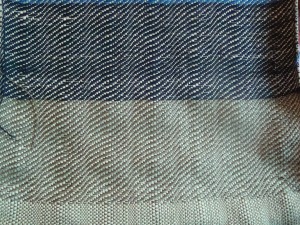
And teal and navy blue.
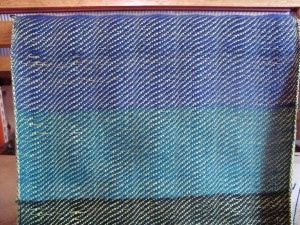
I noticed that the weave structure is a little unstable (the threads are so slippery that they don’t stay in place when subjected to even mild friction),
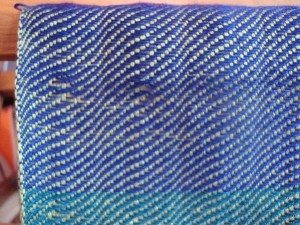
And so I tried a slightly heavier, woolen weft. On the bottom you can see purple bamboo, and on the top purple and teal wool.
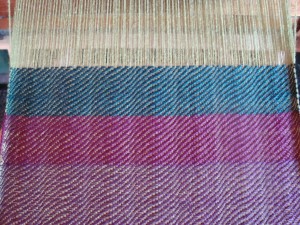
The slightly thicker wool really brings out the wave pattern, and the fabric is more stable, though still a bit delicate, which I hope will work out when I wet-finish the piece.
I finally settled on the teal wool for a weft, and am reveling in texture of this weave. I love the thick, heavy waves of teal, separated by flashes of bright green.
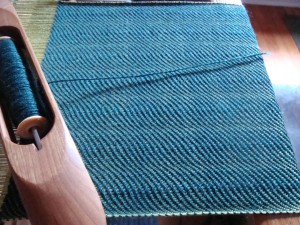
It manages to look different from every angle.
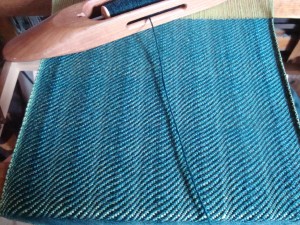
This camera doesn’t do the colors justice, but you will see more when we take it off the loom. It’s so interesting how poorly this warp matched the first project, and how versatile it has proven to be in the second. I could have woven it with any of the colors that I tried. It just needed the quiet of a dark, solid weft to let its true colors shine.
Sun 26 Jun 2011
The secret weaving project has been safely delivered, so now I can show you all what I’ve been up to. (It’s a good thing, too…not blogging about this project was killing me. I’m not sure I could have held out another week!)
Sometime this spring, Becky and I were at a knitting guild meeting, and one of the vendors had a very pretty laceweight yarn. It was a handpaint, with vibrant colors and abrupt color changes. It’s Schaefer Yarn Andrea, in colorway Jane Addams.
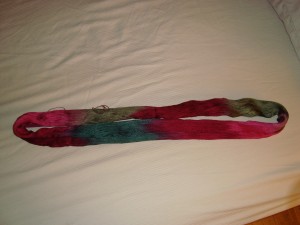
The colors were definitely Becky’s colors, but really, what kind of lace could you knit with that and manage to avoid pooling? And what but lace would you knit with a yarn that has 1100 yards in 3.5 ounces? Becky asked me “what would you do with this?” My immediate response was that I would weave with it.
That planted a thought. During the break, a small paper bag was carefully slipped into my backpack. I was planning to weave it up for Christmas, but then I decided that it would make a good going-away gift, too. And so, I began some deadline crafting.
I had two cones of green yarn that would go with the laceweight. One was a shade or two darker than the darkest green in the yarn, and the other was a couple of shades lighter. (Sorry for the flash…I was in a hurry to get the skein wound into bobbins and couldn’t wait for daylight.)
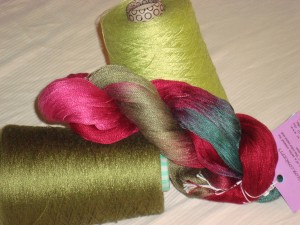
As you know, I decided on the lighter color, thinking that it would help the colors to “pop.” Instead, it completely overwhelmed them:
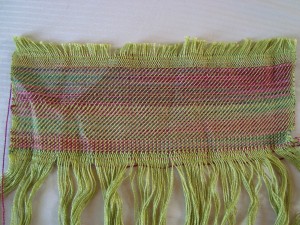
So I took the light warp off the loom, and put on a dark one instead. Can you believe the difference?
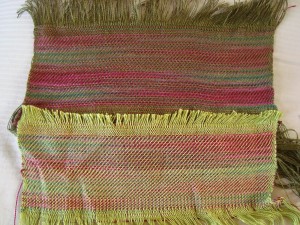
I finished weaving the scarf on Wednesday, washed it Thursday, and gave it Friday. Again, the photos are a little dark because we took them at night, but I think you get the idea.
Even in weaving, the colors did pool quite a bit, but I really like how they interacted. I’ve found that this is consistently true for me; yarns that I would normally avoid knitting with because of pooling make excellent weaving yarns. The uniform width of the piece and the alignment of the color repeats makes the color changes much more acceptable to my eye, and usually makes a beautiful fabric. In this case, I had to be extra careful to line up the color repeats when I switched from one bobbin to the next so that the pattern didn’t shift, but that wasn’t very hard because it only took two and a half bobbins to finish the scarf. Because the width doesn’t change, I was able to keep the same color repeat all the way through the scarf, giving it an interesting zigzag look.
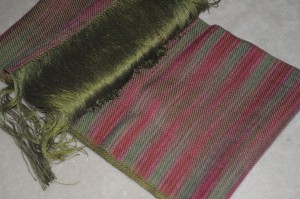
I wove the scarf in a 3/1 twill (the weaving yarn goes over three threads, then under one), so the front and the back look a little different. The laceweight weft is dominant on the front, and the warp is dominant on the back.
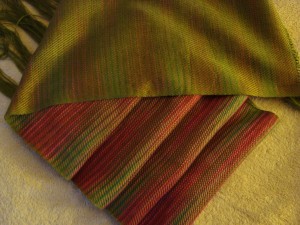
The warp is tencel and the weft is silk, so the piece has beautiful shine and drape. The fabric is quite light because the laceweight is so fine, and the twill pattern gives it a little extra texture, too. See all those little diagonal lines? That’s the twill pattern. (It’s in your jeans, too…they’re a 2/2 twill, where the weaving yarn goes over two threads and then under two threads all the way across the fabric.)
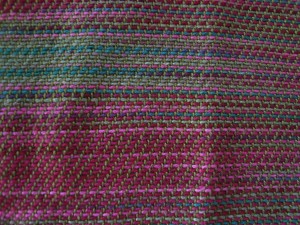
As it turned out, Becky wasn’t the only one getting surprised on Friday. She gave me this beautiful project bag:
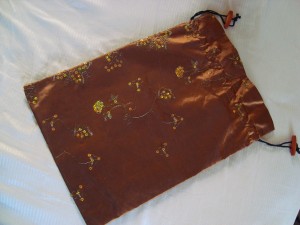
…filled with Pygora fiber! I’ve never spun Pygora, but it is wonderfully soft, and very warm. I’m looking forward to spinning this one; it’s staple length is so short that it will be very different to spin than the longwools that I’ve been using. It will probably become a laceweight, just enough for a small and special project. Another experiment awaits!
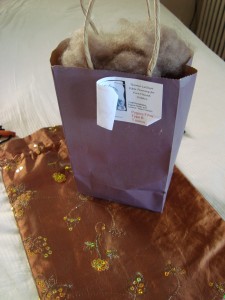
Thu 16 Jun 2011
I pretty much know how to use color in knitting, but in weaving I am still very much feeling my way. It’s an entirely different way to use yarn, and colors can interact in very unexpected ways.
I spent a lot of time last weekend dithering over a light warp or a dark warp. The light one would brighten the yarn that I want to highlight, and I was hoping that it would make things “pop.” The dark one was subtler, but also a good match.
Since I know that I tend to be overly conservative in my color mixing, I compensated and went with the light warp. Today, I finished putting it on the loom (all 300 ends of it).
…and it’s not the right color. It pops alright, but so much that it overwhelms the yarn it was intended to flatter.
Unfortunately, there’s really not a good way to swatch with weaving, besides putting on a full length of warp that’s a few inches wide. I generally find it better to just do the whole thing at once if it’s a narrow piece like this one, rather than winding on part of a warp and then having to go back and add on another, shorter part later. It makes for a lot of up-front investment that’s riding on your guiding vision.
And, frankly, my guiding vison is a bit…fuzzy where this is concerned. I’m afraid we missed the mark this time.
But, better to be late and perfect, so off it comes tonight, to make way for a darker one.
Fortunately, I have lots of other things that will go with this warp, so the yarn won’t be wasted. I’ll lose only the time it took to put it on the loom, and I gain a sample for future reference.
A sample, and a little more experience in color and weave structure. At least I’m learning, yes?
Off to wind another warp, and begin plotting other uses for this one…
Mon 13 Jun 2011
Between the move on the first weekend of June and a conference on the second, this month is just flying past. Suddenly there are only three weeks to go in Madison, and then I’m off to Chicago. It’s craziness, I tell you.
Since the weeks are slipping so quickly past, I am suddenly facing a rather tight deadline on a weaving project that I’d like to get done for a friend before I go. I’m not big on deadline crafting, and I’m even less inclined to secret projects, but if I show you the yarn she’ll know who it’s for. So I’m sorry, but you’ll have to wait until later for full details. Fortunately, “later” really won’t be very long in this case (I hope).
I really, really need to get this project on the loom soon, which means that I’m currently pushing hard to get the potholders off. They’re almost there:
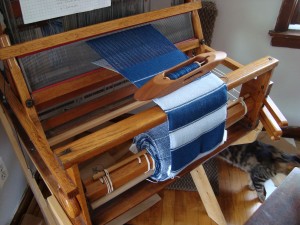
I think I should be able to finish them tonight, if I push hard.
Since I can’t show you what I’ll be putting on the loom next, I thought I might show you some recent acquisitions from a foray to the LYS on Sunday. Perhaps it’s ironic considering the subject of my last post, but both purchases are for weaving this time. They’re shown below with their partner cones from the stash.
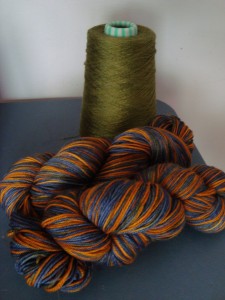
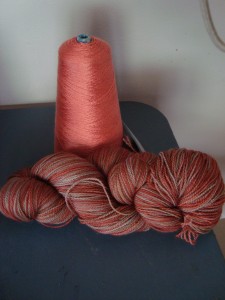
The skeins are from Sun Valley Fibers, a local farm and dyer that makes beautiful yarn. I’ve often been tempted, but haven’t actually given in until now. (I need to round off my frequent buyer card before I leave, you see.)
So there you have it. I had enough yarn before, and now I have enough plus three skeins.
Now if I could just find some time to use it in, I’d be all set…
Thu 26 May 2011
This has been one of those weeks where I find myself saying “what, Thursday already?” Since it’s almost the weekend again, I suppose it’s about time that I post about what I did last weekend.
First, I finished up the leftovers from my doubleweave workshop. There were about 2 yards of warp left over, and the fabric was only about 4 inches wide. What do you do with such a small strip of fabric? Well, I made coasters.
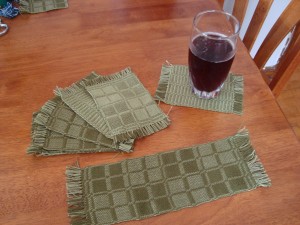
I made some with a dark weft, and some with a light weft. And then I repeated the edging pattern over and over again to make one that looks like it has zigzags all along it (those are my favorites).
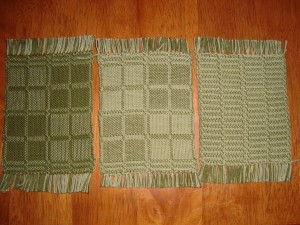
I just love these. We’ve been needing new coasters for a while now, and I’m thrilled to bits with my little magic carpets. (Though they may have had a certain Disney song stuck in my head all weekend.…)
Then, I wove the last few feet of warp on the big loom, so that it will be ready to return next weekend while we have the truck to move Branden to Chicago.
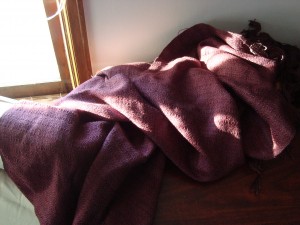
I can’t remember if I’ve blogged about this one before. It’s a rayon warp, with Madeline Tosh laceweight as the weft. The colors are very similar, but the two yarns look different in the light, and the subtle color gradations in the laceweight make for pretty contrast.
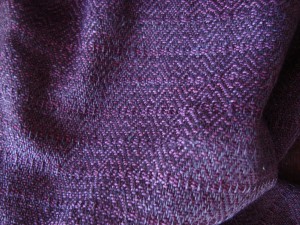
This is the most complicated threading that I’ve done yet, and it was a lot of fun. I definitely want to play more with complex weave patterns. So many things to try…
At the end, I had a few feet of warp left after I ran out of laceweight, so I switched to cotton and did some playing around.
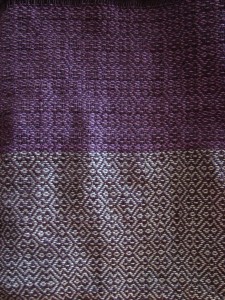
These are two different patterns that use the same warp threading, and you just lift the threads (treadle) in a different way. It’s interesting to me how much difference the weft color makes. I really love the dark laceweight, and the off white, but I don’t really care for the medium toned purple. The colors go well together, but I don’t like the way they interact with the pattern; I find it very hard to see. The off white looks great, though. I think I got enough of that one to make something with it, too.
I think the final finishing on these will probably have to wait until after the move. I did manage to hem stitch the ends of each of the coasters, but these larger pieces will take a little more time and work to get done. Still, I’m excited to know that they’re almost ready to use!
Once the coasters were finished, the little loom was left empty. We can’t have that, so this week I’ve been working on threading up a new project.
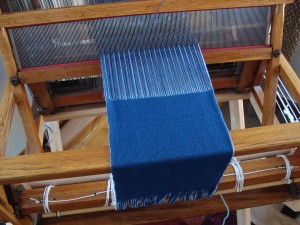
This is a new doubleweave warp. The first part wasn’t behaving quite as nicely as I wanted (I was trying to work too close to the end to avoid waste), so I wove about 10″ that I think will probably become a drawstring bag of some sort. I finished that just before leaving for the bus this morning, and now it’s on to potholders.
So that’s my weaving progress report. Two things off the loom, and another on. I wonder what I’ll get done this weekend?
Tue 5 Apr 2011
If it seemed a little quiet on the blog this weekend, it’s because I was away for a two-day workshop put on by the local weaving guild. The best part about being in the guild (and any craft circle in general) is that we get to see what other people are doing. This workshop was especially fun because it was a round robin. Everyone was given a set of instructions ahead of time, and we all brought looms that were already set up and ready to weave. During the workshop, we switched back and forth between looms, weaving a sample on as many as we could get through (I only missed one that I wanted to try, so the timing was also perfect).
All of the projects were based on a single woven structure, called double weave. Like with double knitting, you’re basically just working two layers of fabric at the same time, except in weaving they don’t necessarily have to be connected into one piece of cloth.
I was familiar with the idea of this technique only as a way of weaving cloth twice as wide as your loom (you weave two layers that are connected along just one side, and then open it up when you take it off the loom). As you can see from the samples below, there are many, many more things to do with double weave than to make wide fabric.
Of course, if you can make two layers of fabric connected on one side, you can make a tube by connecting them on both sides. If you then switch which layer of fabric is on top, you can create pockets, which can be stuffed with things. (Because, you know, we all need pockets in which to put stuffing.)
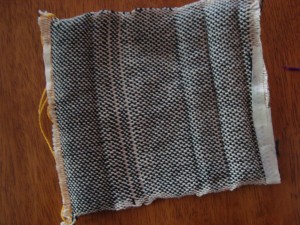
And if you go back and forth between tubes and double-wide fabric, you can have a pocket that opens on the side.
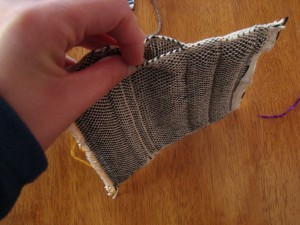
I find that pocket to be very, very exciting. Think of all the things you could weave with pockets in them…
Instead of pockets, you can have blocks of color that switch back and forth.
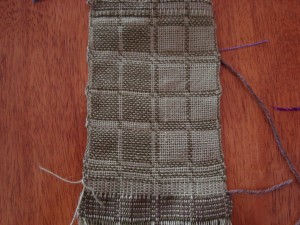
(Actually, each color block is a pocket here, too. They’re just hidden because they’re all sealed up.)
Or, you can use a looser cloth and weave things right into the fabric.
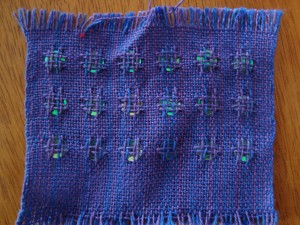
Those are little sequins added in before sealing the pockets up. You can’t really see here, but they do sparkle quite a bit. This isn’t something I would have woven for myself, but it was fun to try. There has to be some use for it…maybe buttons rather than sequins?
If you’re willing to get a little more complicated (and have the loom to do it), then the blocks don’t have to be plain anymore. The other side of this fabric is perfectly reversed, and it’s all made up of blocks that are black and white on one side and red on the other. Unfortunately, I ran out of time on this one, but you get the idea.
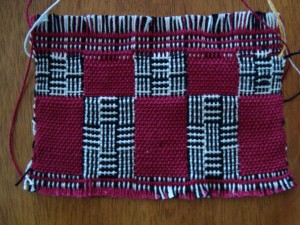
You can also do amazing things with color.
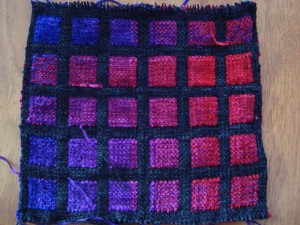
This piece is one of my favorites, simply because the colors are so spectacular. On the reverse side, the squares are black and the lines are colored. I want to make this, except I don’t have enough shafts on my loom. Someday…
If you don’t want blocks, you can always have the layers switch back and forth in a different sequence. This piece looks the same on the back, except that the blocks are blue and the lines are white.
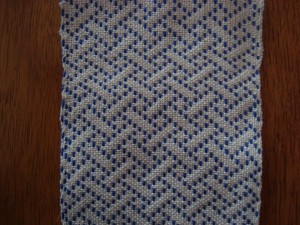
And then again, you don’t have to weave the second layer at all. This leno lace is made by weaving one layer (the background color), and letting the other have really long floats. Then you go back and twist the floats around one another to get an hourglass shape.
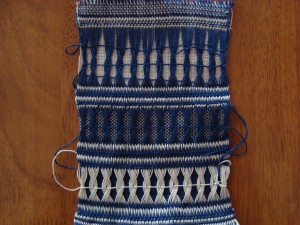
Lots of things to play with here! This has only scratched the surface of what’s possible, and I can definitely see myself using double weave for some future project. Not a bad way to spend a weekend!































